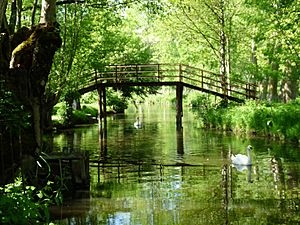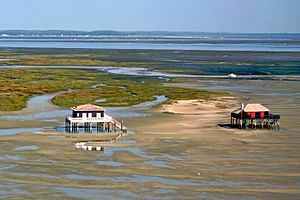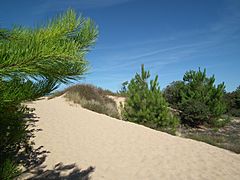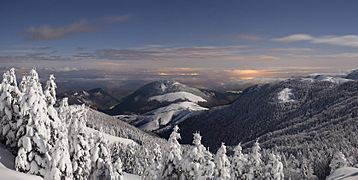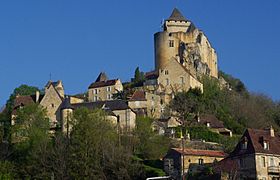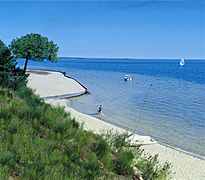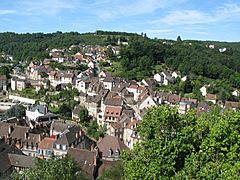Nouvelle-Aquitaine facts for kids
Quick facts for kids
Aquitaine-Limousin-Poitou-Charentes
|
|
|---|---|
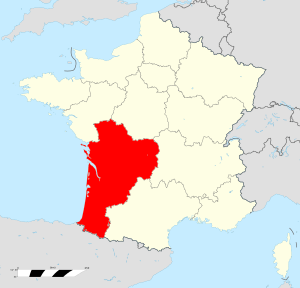 |
|
| Country | |
| Departments | |
| Area | |
| • Total | 84,061 km2 (32,456 sq mi) |
| Population
(2012)
|
|
| • Total | 5,808,594 |
| • Density | 69.0997/km2 (178.9675/sq mi) |
| Time zone | UTC+1 (CET) |
| • Summer (DST) | UTC+2 (CEST) |
Aquitaine-Limousin-Poitou-Charentes is a future Region of Southwestern France, created by the territorial reform of French Regions in 2014 by merger of Aquitaine, Limousin, and Poitou-Charentes.
Larger than French Guiana, it will be the largest region in France, with an area equal of Austria. Its largest city, Bordeaux, together with its suburbs and satellite cities, forms the 7th metropolitan area of France, with 850,000 inhabitants. Since 1 January 2015, Bordeaux have the status of “ Métropole ”
The region has 25 major urban areas among which the most important are - apart from Bordeaux and its 1,140,000 inhabitants - Bayonne and Limoges (283,000 inhabitants), Poitiers (255 000), Pau (241 000) and La Rochelle (206 000), as well as 11 major clusters. The growth of its population, particularly marked on the coast, will make one of the most attractive areas of French territory: the new region will outperform the Île-de-France and Provence-Alpes-Côte d'Azur in terms of demographic dynamism.
Its economy is based on agriculture and viticulture (vineyards of Bordeaux and Cognac, internationally known), on tourism, on a powerful aerospace industry, digital economy and design, parachemical and pharmaceutical industries, financial sector (Niort is the fourth French financial place, specializing in mutual insurance companies) and industrial ceramics (Limoges). Its coastline has seen locate many companies specializing in sliding sports, mainly surf.
Contents
Geography
The region Aquitaine-Limousin-Poitou-Charentes result of the merger of three local authorities (Aquitaine, Limousin and Poitou-Charentes) decided in the framework of the territorial reform in 2014. Covering 84,061 square kilometers, larger than the French Guiana, it will be the largest region in France (mainland and overseas-alike). It is one of the four constituent parts of the “Midi de la France” (Southern France).
Aquitaine-Limousin-Poitou-Charentes is limited by the Pays de la Loire to the north-west, the Centre-Val de Loire to the north, Auvergne-Rhône-Alpes to the east, Languedoc-Roussillon-Midi-Pyrénées to the south-east and Spain to the south. The region covers a large part of the Aquitaine Basin and a small portion of the Paris Basin (the border between the two being located at the "Seuil du Poitou") and the Limousin plate (part of the Massif Central) and the western part of the Pyrenees. It is part of five watersheds facing the Atlantic Ocean: Loire, Charente, Garonne and Dordogne (and their extension, the Gironde estuary) and Adour, giving rivers bordering land dedicated mostly to viticulture and to agriculture.
Aquitaine-Limousin-Poitou-Charentes also relies on the presence of a large open coastline on the Atlantic Ocean, from the National Nature Reserve Aiguillon Bay and the estuary of the Sèvre (north Charron) than Bidasoa (south of Hendaye) and including the islands of the Charentais Archipelago (islands of Ré, Oléron, Aix and Madame) and the wide notch from Arcachon. This diverse area is the area of the oyster (Marennes-Oléron and the Bassin d’Arcachon), mussel (mussels from Baie de l’Aiguillon), and Tourism, evidenced by the presence of famous resorts such Arcachon (Côte d’Argent), Biarritz (Côte Basque) and Royan (Côte de Beauté).
Since the Arvert peninsula to the coast of Labourd, coastline, almost straight, is lined with high dunes, rising to the Dune du Pilat, large lakes (Lac d'Hourtin-Carcans, étang de Lacanau, étang de Cazaux et de Sanguinet , lac de Biscarrosse et de Parentis...) and wetlands (réserve naturelle nationale des dunes et marais d'Hourtin) above vast pine forests planted in the nineteenth century. The Landes forest, by far the most extensive, covering almost one million hectares (nearly 950,000 of maritimes pins), making it the largest artificial forest of Western Europe. Forming a vast triangle starting from the Pointe de Grave, north of Soulac-sur-Mer to Hossegor in the south and east Nérac, it replaced the thankless, sandy and marshy moorland that characterized the region for centuries. The Landes forest is partially included in the Landes de Gascogne Regional Natural Park, which begins south of Bordeaux.
Further north, in the wake of the Landes forest, on the right bank of the Gironde estuary, the forest of la Coubre presents the same characteristics, forming the main "green lung" of Royan on nearly 8000 hectares. Other important forests cover the region: in the Basque Country, the Irati Forest covers over 17,000 hectares; at the borders of the Charente, Charente-Maritime and Dordogne, the forest of the Double, punctuated by nearly 500 lakes, spans about 50,000 hectares; further north, near Poitiers, Moulière forest stretches nearly 6,800 hectares. Further east, close to Guéret, the Chabrières forest reaches 2000 hectares.
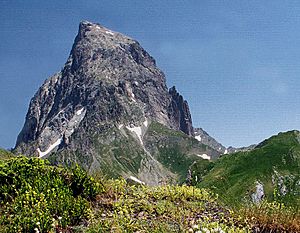
The extreme southern region has a mountainous character with the presence of the Pyrenees. If its western part (mountains of Labourd) is made more high green hills generally struggling to reach 1000 meters (La Rhune, near Bayonne, is 905 meters high, but further east, the culmination of French Basque Country, the pic d'Orhy, nevertheless amounts to 2017 m), the Pau region is marked by more mineral landscapes, and is surrounded by high peaks often exceeding 2000 meters. The highlight of the region, the Pic Palas (2974 m) is located not far away. Other Pyrenean peaks located in the region are also spectacular Pic du Midi d'Ossau (2884 meters), the Pic d'Arriel (2824 m), the Pic de Ger (2613 m) near the Winter resort Gourette, Pic d’Anie (2504 m), the Latte de Bazen (2472 m), the Pic d'Ansabère (2377 m), the Pic d'Arraille (2147 m) or the Pic d'Arlas ( 2044 m).
This hilly region is traversed many mountain streams, called gaves: among these include the Gave de Pau, the gave de Bious the Gave d'Ossau or the Gaves réunis, on the border of Landes and Pyrénées-Atlantiques . Ossau Valley, one of the three valleys of Béarn, extends from the suburbs of Pau to Col du Pourtalet to the Spanish border. Glacial lakes, its fauna and flora exceptional explain its integration into the Pyrénées National Park.
Belonging to the Massif Central, Limousin also has a marked relief, with its high plateaus and some hedgerow eroded peaks that dominate green valleys and forests of oak and chestnut trees. Limousin plateau, cut by the valleys of the Vienne (who waters his capital, Limoges) Isle, Vézère or the picturesque Corrèze, with its cashed reliefs, hardly exceeds 500 meters. It marks the watershed line between the Loire basin to the north (the sources of the Briance, the Aixette, the Grêne or the Gorre), the basin south of the Dordogne (sources of Dronne, of Isle and of Auvézère) and maritime watershed of the Charente, in the west.

The mountains of Limousin, which include a series of small mountains (mont Fayat, Monedières Hills, mont de Châlus) peak at Mont Bessou (976 m), in Corrèze. Further north, the mountains of Marche, which are divided into mountains of monts de Guéret, mont d'Ambazac and monts de Blond, are more like high wooded hills dotted with pastures, as real peaks. They culminate in Signal de Sauvagnac (701 m), in Haute-Vienne. Southwest of Limousin and Périgord northwest since 1998 are integrated to the Parc naturel régional Périgord Limousin.
The northern part of the region, which corresponds to the Haut-Poitou history, is organized around a tray agricultural and viticultural (vineyard of Haut-Poitou) irrigated by the Vienne, Clain or the Gartempe, which form so little valleys, often lined with oak forests. Further south, the Niortais this open landscapes (openfields) in grain dominant, but also rich wetland areas such as the Marais Poitevin, a legacy of an old marine gulf filled with alluvium, which is divided into wet marshes (we speaks more readily of "Green Venice") and marshes dried up, converted into mixed farming. Niort, on the Sèvre Niortaise, main town of the Haut-Poitou outside Poitiers, is like a door of this "Green Venice" much of which belongs to the parc naturel régional du Marais poitevin, established in 1979, classified "Grand site de France".
Further south lie the Charentes, which correspond to the former provinces of Aunis, Angoumois and Saintonge. Aunis is not unlike the landscape of Niortais, with large marshes that extend from either side of La Rochelle and Rochefort (Baie d'Yves, marais de Rochefort, Broue and Brouage) but also the islands of Ré and Aix, with varied landscapes where pine forests mingle, sandy beaches or the curious lagoon of Fier d'Ars, the sands in constant motion, which houses a bird sanctuary. The interior of the territory is marked by the presence of a rich plain cereal evoking the Beauce by its open relief on the horizon. At the center of this space, the city of Surgères remained a pastureland where dairy farming has retained its importance: the small city is thus a production centers butter, Beurre de Charentes-Poitou.
The Angoumois forms a transitional space between the coastal plains of Aunis, large "champagne" of Saintonge and Limousin plateau. Dotted with small hills, he seems to live to the rhythm of the Charente, real artery watering its major cities, Angoulême, Cognac and Jarnac. Great wine region, internationally renowned alcohol is produced there, cognac, and a water spirits called Pineau des Charentes. The western quarter of Charentes consists of Saintonge, organized territory around the towns of Saintes, the first capital of Aquitaine in Roman times, and Royan.
In continuation of the Angoumois, the Dordogne approximately corresponds to the former province of Périgord. Taking its name from the river of the same name, which flows Bergerac but not its prefecture, Périgueux (the edge of the Isle), the area with varied landscapes has a large afforestation rate (45%) making it the third most wooded department France. The great forests of oak and chestnut trees of green Périgord, organized around Nontron, meet the great grain fields of the White Périgord, nicknamed "the breadbasket of the Périgord", the oak, walnut and black Périgord truffle, around Sarlat-la-Caneda and vineyards of Bergerac or purple Périgord, which produces Bergerac, monbazillac or pécharmant.
The Gironde estuary, which acts as a link between Saintonge, Blayais, Médoc and western Guyenne, is in itself a world apart. Wild largest estuary in Europe, being classified in the marine park with the "Pertuis charentais", it is lined with large marshes ("Petite Camargue" and hillsides which produces most of the great Bordeaux wines from the Côtes-de-Bordeaux and Côtes-de-Bourg on the right bank to the great wines of the left bank Médoc (Pauillac, Margaux, Saint-Estèphe, Saint-Julien. The vineyards of Bordeaux, with international reputation, has done for centuries the reputation of the region. His productions are exported worldwide.
Farther south lies the vast plain Landes (south of Gironde and Landes), which begins near Bordeaux and go to the Pyrénées. Largely occupied by the Landes forest, it is also a major agricultural area (maize farming) and hosts a spa of international reputation, Dax, also the capital of Chalosse, important breeding ground.
The coastline subject to severe erosion, remained very wild. Some resorts have been built in the dunes from Soulac-sur-Mer in the north of the Gironde, via Lacanau, Hourtin, Biscarrosse, Mimizan and Capbreton, without forgetting those bordering the Bay of Arcachon: Arcachon, Andernos-les-Bains, Lège-Cap-Ferret, Pyla-sur-Mer. This vast lagoon, wide open ocean, houses since 2014 the marine natural park of Arcachon basin.
Eastern Guyenne corresponds in part to the department of Lot-et-Garonne. Rich agricultural and farming area watered by both the Lot and the Garonne, it is famous for its "pruneaux", who took the name of its capital, Agen (nearly 8000 hectares of land are dedicated to Ente plum orchards) while Marmande is famous for its tomatoes. The mild climate explains that also cultivated tobacco, as well as strawberries ("gariguettes") and vines, used to produce the Côtes du marmandais the buzet or Côte de Brulhois, that relate to the broad vineyard of the Southwest. But the real glory of this land is Armagnac, a famous brandy, exported around the world. Its vineyards cover some of the departments of Lot-et-Garonne, Landes but also the Gers (in the neighboring region of Languedoc-Roussillon-Midi-Pyrénées). It also produces the floc de Gascogne, with delicate floral accents.
The extreme south of the region consists of two territories in strong identity, the Basque Country (Northern Basque Country or "Ipparalde") and Béarn. The first, which is organized around Bayonne, Biarritz, Saint-Jean-de-Luz (Labourd) Mauléon-Licharre (Soule) and Saint-Jean-Pied-de-Port (Lower Navarre) has its warm and humid climate its green side, the Atlantic rains from butter against the Pyrenean barrier. The coast, with its posh resorts or family, makes it a popular holiday resort. The interior, more rural, retains a strong agricultural tradition and a solid wine region, symbolized by the vineyard irouléguy but also by traditional liquors such as izarra and patxaran, eau-de-vie characteristic of Navarre .
Anchored in the heart of the Pyrenees, the Béarn opposes his Gascon traditions. Has a succession of gently accented hills and valleys (that of Pau river, which concentrates the capital, Pau, and several cited as Orthez and Navarrenx, being the most populated), it comprises the Vallée d'Aspe, the vallée de Barétous and col du Soulor. Agriculture will always prominently, as viticulture (jurançon, Madiran) even if the aeronautical and petrochemical sectors are also represented. It was in Béarn that are concentrated the main ski resorts in the area, such Artouste, Gourette, Issarbe, La Pierre Saint-Martin and Le Somport.
-
Sands dune in île d'Oléron (Charente-Maritime)
-
The vallée de Barétous (Pyrénées-Atlantiques)
-
Medieval city of Castelnaud-la-Chapelle (Dordogne)
-
The main lake of Biscarrosse (Landes)
-
Old town of Aubusson (Creuse)
Climate
The region Aquitaine-Limousin-Poitou-Charentes essentially has a more or less altered oceanic climate. We distinguish the Aquitaine oceanic climate, which concerns most of the territory (Charentes to Landes), the Paris oceanic climate (Poitou), Limousin oceanic climate, tinged with semi-continental influences (Limousin) and basque microclimate, wetter (western half of the Pyrénées-Atlantiques and southern Landes). The Pyrenean has a specific climate that varies with altitude: the Pyrenean climate, which is a variation of mountain climate.
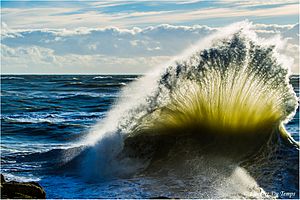
In the north of the region, the Paris oceanic climate is marked by moderate rainfall, warm summers and cool winters, but without excess. The Seuil du Poitou acts as a relative climatic barrier and regions further south belong to the oceanic climate area Aquitaine. Coastal areas are wetter overall, with moderate rainfall spread throughout the year, except for the summer months, where droughts are not uncommon. Summer, relatively warm, are tempered by sea breezes, and winters are warm. Frosts are rare and snow exceptional. Sunshine is important around 2 000 to 2 200 hours per year, which is comparable to some Mediterranean regions (Perpignan). Summer precipitation often take the form of thunderstorms, possibly violent, while winter is sometimes marked by storms, some of which have marked the area with their exceptional: Martin in 1999 (record of 198 km / h in Saint-Denis-d'Oléron), Klaus in 2009 (172 km / h to Biscarrosse) and Xynthia in 2010 (160 km / h on the Île de Ré).
The climate is Angoumois and Limousin, wetter and cooler, remains temperate with warm spring and relatively warm summers, with variations due to altitude. The annual sunshine averaged 1850 hours. The climate of the Basque country and southern Landes is distinguished by its warm summers, mild winters but especially by its high rainfall, the Atlantic depressions abutting the Pyrenean foothills. Microclimate This explains the presence of lush vegetation and the green aspect of the region, which is different from the Spanish side. Fogs are not rare, but usually dissipate very quickly.
As for the Pyrenean climate, suboceanic trend Béarn, it is subject to frequent "cap effect" when the north-west of disturbances abut against the Pyrenean mountains. Valley bottoms, true "funnels clouds" are particularly watered. The winter snow is important above 1200 meters. Pau valley has a microclimate, however, marked by strong sunlight (about 1900 hours a year) but high rainfall (1100 mm per year) and a near absence of frost in winter. Rainfall is usually brief there, but regular, and spread throughout the year.
Images for kids
-
The ring road of Bordeaux supports a particularly heavy traffic.
-
Royan harbour by night.
-
The business district of Mériadeck at Bordeaux, remained on a human scale.
-
Blonde d'Aquitaine in the Pyrenees.
-
The Turbomeca Arriel turboshaft engine, manufactured in Bordes (Pyrénées-Atlantiques).
See also
 In Spanish: Nueva Aquitania para niños
In Spanish: Nueva Aquitania para niños



